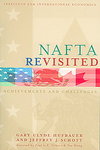![]()
 NAFTA entered into force in 1994 after a bitter Congressional debate. But NAFTA in operation has proved no less controversial than NAFTA before ratification, for both supporters and opponents of trade liberalization have cited experience with the agreement to justify their positions. To provide a factual basis for this ongoing debate, the authors evaluate NAFTA’s performance since its inception, comparing actual experience with both the objectives of the agreement’s supporters and the charges of its critics. They examine future challenges and opportunities in the trade and investment relationships among the three partner countries and the broader implications for new trade initiatives throughout the hemisphere. Chapter 1 describes trade, investment, and macroeconomic developments under NAFTA, beginning inauspiciously with the Mexican economic crisis of 1994 but moving on to impressive growth in trilateral trade and Mexican GDP. Chapter 2 traces the implementation of NAFTA’s dispute settlement provisions and the progress to date in implementing reforms. Chapter 3 distills and updates the findings from NAFTA and the Environment: Seven Years Later and recommends how to improve the performance of NAFTA’s institutions in addressing environmental problems. Chapter 4 undertakes a similar assessment of the operations of the North American Agreement on Labor Cooperation and the impact of NAFTA on employment and wages in the region. Chapters 5 and 6 examine integration in the North American auto and energy markets. The final chapter looks forward and focuses on the challenges facing North American economic integration on important issues such as immigration, environment, energy, and exchange rates. © 1998-2001 Amazon.com, Inc. und Tochtergesellschaften
NAFTA entered into force in 1994 after a bitter Congressional debate. But NAFTA in operation has proved no less controversial than NAFTA before ratification, for both supporters and opponents of trade liberalization have cited experience with the agreement to justify their positions. To provide a factual basis for this ongoing debate, the authors evaluate NAFTA’s performance since its inception, comparing actual experience with both the objectives of the agreement’s supporters and the charges of its critics. They examine future challenges and opportunities in the trade and investment relationships among the three partner countries and the broader implications for new trade initiatives throughout the hemisphere. Chapter 1 describes trade, investment, and macroeconomic developments under NAFTA, beginning inauspiciously with the Mexican economic crisis of 1994 but moving on to impressive growth in trilateral trade and Mexican GDP. Chapter 2 traces the implementation of NAFTA’s dispute settlement provisions and the progress to date in implementing reforms. Chapter 3 distills and updates the findings from NAFTA and the Environment: Seven Years Later and recommends how to improve the performance of NAFTA’s institutions in addressing environmental problems. Chapter 4 undertakes a similar assessment of the operations of the North American Agreement on Labor Cooperation and the impact of NAFTA on employment and wages in the region. Chapters 5 and 6 examine integration in the North American auto and energy markets. The final chapter looks forward and focuses on the challenges facing North American economic integration on important issues such as immigration, environment, energy, and exchange rates. © 1998-2001 Amazon.com, Inc. und Tochtergesellschaften
Hufbauer, Gary Clyde and Jeffrey J. Schott. NAFTA Revisited: Achievements and Challenges. Institute for International Economics, 2005.
